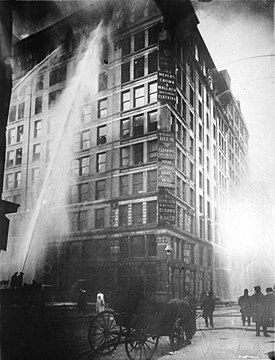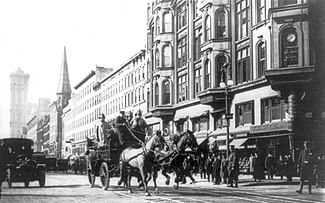New York
Related: About this forumTriangle Shirtwaist Factory Fire March 25 1911 (THIS is what the admin wants for us!!)
Triangle Shirtwaist Factory fire

The Triangle Shirtwaist Factory fire in New York City on March 25, 1911, was the deadliest industrial disaster in the history of the city, and one of the deadliest in U.S. history.[1] The fire caused the deaths of 146 garment workers – 123 women and 23 men[2] – who died from the fire, smoke inhalation, or falling or jumping to their deaths. Most of the victims were recent Italian and Jewish immigrant women aged 14 to 23;[3][4][5] of the victims whose ages are known, the oldest victim was 43-year-old Providenza Panno, and the youngest were 14-year-olds Kate Leone and Rosaria "Sara" Maltese.[6] The factory was located on the 8th, 9th, and 10th floors of the Asch Building, at 23–29 Washington Place in the Greenwich Village neighborhood of Manhattan. The 1901 building still stands today and is known as the Brown Building. It is part of and owned by New York University.[7]
Because the doors to the stairwells and exits were locked[8][1] (a then-common practice to prevent workers from taking unauthorized breaks and to reduce theft),[9] many of the workers who could not escape from the burning building jumped from the high windows. The fire led to legislation requiring improved factory safety standards and helped spur the growth of the International Ladies' Garment Workers' Union (ILGWU), which fought for better working conditions for sweatshop workers.
. . . .
The Triangle Waist Company[11] factory occupied the 8th, 9th, and 10th floors of the 10-storey Asch Building on the northwest corner of Greene Street and Washington Place, just east of Washington Square Park, in the Greenwich Village neighborhood of New York City. Under the ownership of Max Blanck and Isaac Harris, the factory produced women's blouses, known as "shirtwaists". The factory normally employed about 500 workers, mostly young immigrant women, who worked nine hours a day on weekdays plus seven hours on Saturdays,[12] earning for their 52 hours of work between $7 and $12 a week,[9] the equivalent of $191 to $327 a week in 2018 currency, or $3.67 to $6.29 per hour.[13]
At approximately 4:40 p.m. on Saturday, March 25, 1911, as the workday was ending, a fire flared up in a scrap bin under one of the cutter's tables at the northeast corner of the 8th floor.[14] The first fire alarm was sent at 4:45 p.m. by a passerby on Washington Place who saw smoke coming from the 8th floor.[15] Both owners of the factory were in attendance and had invited their children to the factory on that afternoon.[16] The Fire Marshal concluded that the likely cause of the fire was the disposal of an unextinguished match or cigarette butt in the scrap bin, which held two months' worth of accumulated cuttings by the time of the fire.[17] Beneath the table in the wooden bin were hundreds of pounds of scraps left over from the several thousand shirtwaists that had been cut at that table. The scraps piled up from the last time the bin was emptied, coupled with the hanging fabrics that surrounded it; the steel trim was the only thing that was not highly flammable.[14] Although smoking was banned in the factory, cutters were known to sneak cigarettes, exhaling the smoke through their lapels to avoid detection.[18] A New York Times article suggested that the fire may have been started by the engines running the sewing machines. A series of articles in Collier's noted a pattern of arson among certain sectors of the garment industry whenever their particular product fell out of fashion or had excess inventory in order to collect insurance. The Insurance Monitor, a leading industry journal, observed that shirtwaists had recently fallen out of fashion, and that insurance for manufacturers of them was "fairly saturated with moral hazard." Although Blanck and Harris were known for having had four previous suspicious fires at their companies, arson was not suspected in this case.[16]

. . . . .
https://en.wikipedia.org/wiki/Triangle_Shirtwaist_Factory_fire
. . . .
Triangle Shirtwaist Factory Fire
On March 25, 1911, the Triangle Shirtwaist Company factory in New York City burned, killing 145 workers. It is remembered as one of the most infamous incidents in American industrial history, as the deaths were largely preventable–most of the victims died as a result of neglected safety features and locked doors within the factory building. The tragedy brought widespread attention to the dangerous sweatshop conditions of factories, and led to the development of a series of laws and regulations that better protected the safety of workers.
The Triangle factory, owned by Max Blanck and Isaac Harris, was located in the top three floors of the Asch Building, on the corner of Greene Street and Washington Place, in Manhattan. It was a true sweatshop, employing young immigrant women who worked in a cramped space at lines of sewing machines. Nearly all the workers were teenaged girls who did not speak English, working 12 hours a day, every day. In 1911, there were four elevators with access to the factory floors, but only one was fully operational and the workers had to file down a long, narrow corridor in order to reach it. There were two stairways down to the street, but one was locked from the outside to prevent stealing and the other only opened inward. The fire escape was so narrow that it would have taken hours for all the workers to use it, even in the best of circumstances.
. . . . .
The danger of fire in factories like the Triangle Shirtwaist was well-known, but high levels of corruption in both the garment industry and city government generally ensured that no useful precautions were taken to prevent fires. Blanck and Harris already had a suspicious history of factory fires. The Triangle factory was twice scorched in 1902, while their Diamond Waist Company factory burned twice, in 1907 and in 1910. It seems that Blanck and Harris deliberately torched their workplaces before business hours in order to collect on the large fire-insurance policies they purchased, a not uncommon practice in the early 20th century. While this was not the cause of the 1911 fire, it contributed to the tragedy, as Blanck and Harris refused to install sprinkler systems and take other safety measures in case they needed to burn down their shops again. Added to this delinquency were Blanck and Harris’ notorious anti-worker policies. Their employees were paid a mere $15 a week, despite working 12 hours a day, every day. When the International Ladies Garment Workers Union led a strike in 1909 demanding higher pay and shorter and more predictable hours, Blanck and Harris’ company was one of the few manufacturers who resisted, hiring police as thugs to imprison the striking women, and paying off politicians to look the other way.
On March 25, a Saturday afternoon, there were 600 workers at the factory when a fire began in a rag bin. The manager attempted to use the fire hose to extinguish it, but was unsuccessful, as the hose was rotted and its valve was rusted shut. As the fire grew, panic ensued. The young workers tried to exit the building by the elevator but it could hold only 12 people and the operator was able to make just four trips back and forth before it broke down amid the heat and flames. In a desperate attempt to escape the fire, the girls left behind waiting for the elevator plunged down the shaft to their deaths. The girls who fled via the stairwells also met awful demises–when they found a locked door at the bottom of the stairs, many were burned alive.
. . . . .
https://www.history.com/topics/early-20th-century-us/triangle-shirtwaist-fire